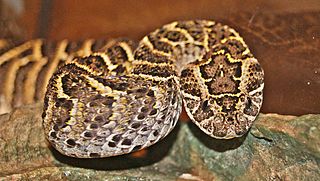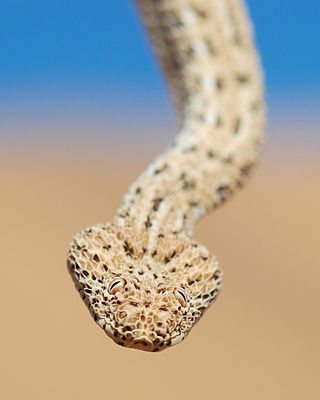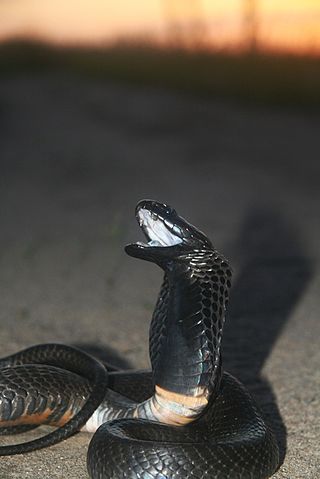
The boomslang is a highly venomous snake in the family Colubridae. The species is native to Sub-Saharan Africa.

The Gaboon viper, also called the Gaboon adder, is a viper species found in the rainforests and savannas of sub-Saharan Africa. Like all other vipers, it is venomous. It is the largest member of the genus Bitis, and has the longest fangs of any venomous snake – up to 2 inches (5 cm) in length – and the highest venom yield of any snake. No subspecies are recognized.

The puff adder is a highly venomous viper species found in savannahs and grasslands from Morocco and western Arabia throughout Africa except for the Sahara and rainforest regions. It is responsible for causing the most snakebite fatalities in Africa owing to various factors, such as its wide distribution, frequent occurrence in highly populated regions, and aggressive disposition. Like all other vipers, it is venomous. Two subspecies are currently recognized, including the nominate subspecies described here.

Chrysopelea ornata is a mildly venomous opisthoglyphous (rear-fanged) colubrid snake found in both South and Southeast Asia. It is commonly known as the golden tree snake, ornate flying snake, and golden flying snake. Along with the other species in the Chrysopelea genus, the golden tree snake is very unusual, as it is capable of a type of gliding "flight" —mainly utilised during the pursuit of prey animals—from tree-to-tree. This action is also used to great effect for the snake to flee its own potential predators. Currently, three subspecies are recognised. The snake's striking looks, and potential for gliding, have made it a coveted choice for captivity.

The Cape cobra, also called the yellow cobra, is a moderate-sized, highly venomous species of cobra inhabiting a wide variety of biomes across southern Africa, including arid savanna, fynbos, bushveld, desert, and semidesert regions.

The western diamondback rattlesnake or Texas diamond-back is a rattlesnake species and member of the viper family, found in the southwestern United States and Mexico. Like all other rattlesnakes and all other vipers, it is venomous. It is likely responsible for the majority of snakebite fatalities in northern Mexico and the greatest number of snakebites in the U.S. No subspecies are currently recognized.

Bitis peringueyi, also known as the Peringuey's adder, Peringuey's desert adder or desert sidewinding adder, is a venomous viper species found in Namibia and southern Angola. No subspecies are currently recognized.

The augur buzzard is a fairly large African bird of prey. This species is distinct in typical adult plumage for its blackish back, whitish underside and orange-red tail, while juvenile augur buzzards are generally rather brown in colour; however a dark morph is known, which causes the bird's entire body to become darker. This member of the Buteo genus is distributed in several parts of the central and southern Africa, normally being found from Ethiopia to southern Angola and central Namibia. It is resident and non-migratory throughout its range. This is a species of mountains, and adjacent savannah and grassland. This is a typical buteonine raptor, being a generalist predator which tends to prefer small mammals supplemented by reptiles and birds among various prey items.

The tiger rattlesnake is a highly venomous pit viper species found in the southwestern United States and northwestern Mexico. No subspecies are currently recognized. The specific name tigris,, refers to the many narrow dorsal crossbands, which create a pattern of vertical stripes when viewed from the side.

Telescopus, the Old World catsnakes, is a genus of 12 species of mildly venomous opisthoglyphous snakes in the family Colubridae.

The European cat snake, also known as the Mediterranean cat snake, is a non venomous colubrid snake endemic to the Mediterranean and Caucasus regions.

The rock monitor is a species of monitor lizard in the family Varanidae. The species is endemic to sub-Saharan Africa, where, on average it is the largest lizard found on the continent. It is called leguaan or likkewaan in some areas.

The black-necked spitting cobra is a species of spitting cobra found mostly in sub-Saharan Africa. They are moderately sized snakes that can grow to a length of 1.2 to 2.2 m in length. Their coloration and markings can vary considerably. They prey primarily on small rodents. They possess medically significant venom, although the mortality rate for untreated bites on humans is relatively low. Like other spitting cobras, they can eject venom from their fangs when threatened. The neurotoxic venom irritates the skin, causing blisters and inflammation, and can cause permanent blindness if the venom makes contact with the eyes and is not washed off.

Jameson's mamba is a species of highly venomous snake in the family Elapidae. The species is native to equatorial Africa. A member of the mamba genus, Dendroaspis, it is slender with dull green upper parts and cream underparts and generally ranges from 1.5 to 2.2 m in total length. Described by Scottish naturalist Thomas Traill in 1843, it has two recognised subspecies. The nominate subspecies is found in central and western sub-Saharan Africa, and the eastern black-tailed subspecies is found eastern sub-Saharan Africa, mainly western Kenya.

Aspidelaps lubricus, commonly known as the Cape coral snake, Cape coral cobra or coral shield cobra, is a species of venomous snake in the family Elapidae. The species is endemic to southern Africa.

Anchieta's cobra, sometimes referred to as the Angolan cobra, is a species of venomous snake in the family Elapidae. The species is native to Southern Africa.

The large-eyed green tree snake, also known commonly as the splendid dagger-tooth tree snake, is a species of venomous snake in the subfamily Colubrinae of the family Colubridae. The species is endemic to Africa. There are three recognized subspecies.

Telescopus beetzi, commonly known as Beetz's tiger snake, is a species of snake in the family Colubridae. The species is native to southern Africa.



















